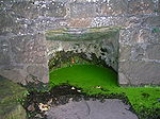
Holy well
Encyclopedia
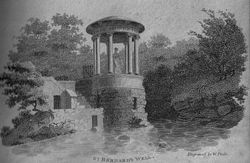
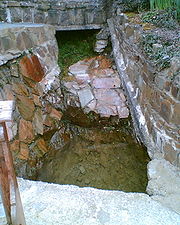
Spring (hydrosphere)
A spring—also known as a rising or resurgence—is a component of the hydrosphere. Specifically, it is any natural situation where water flows to the surface of the earth from underground...
, is a small body of water emerging from underground and revered either in a Pagan
Paganism
Paganism is a blanket term, typically used to refer to non-Abrahamic, indigenous polytheistic religious traditions....
or Christian
Christian
A Christian is a person who adheres to Christianity, an Abrahamic, monotheistic religion based on the life and teachings of Jesus of Nazareth as recorded in the Canonical gospels and the letters of the New Testament...
context, often both. Holy wells were frequently pagan sacred sites that later became Christianized
Christianization
The historical phenomenon of Christianization is the conversion of individuals to Christianity or the conversion of entire peoples at once...
. The term 'holy well' is commonly employed to refer to any water source of limited size (i.e. not a lake or river, but including pools and natural springs and seeps), which has some significance in the folklore
Folklore
Folklore consists of legends, music, oral history, proverbs, jokes, popular beliefs, fairy tales and customs that are the traditions of a culture, subculture, or group. It is also the set of practices through which those expressive genres are shared. The study of folklore is sometimes called...
of the area where it is located, whether in the form of a particular name, an associated legend
Legend
A legend is a narrative of human actions that are perceived both by teller and listeners to take place within human history and to possess certain qualities that give the tale verisimilitude...
, the attribution of healing qualities to the water through the numinous
Numen
Numen is a Latin term for a potential, guiding the course of events in a particular place or in the whole world, used in Roman philosophical and religious thought...
presence of its guardian spirit or Christian saint, or a ceremony or ritual centred on the well site. In Christian legend, the water is often said to have been made to flow by the action of a saint, a familiar theme especially in the hagiography
Hagiography
Hagiography is the study of saints.From the Greek and , it refers literally to writings on the subject of such holy people, and specifically to the biographies of saints and ecclesiastical leaders. The term hagiology, the study of hagiography, is also current in English, though less common...
of Celtic saints.
Nomenclature and etymology
The term haeligewielle is in origin an Anglo-SaxonOld English language
Old English or Anglo-Saxon is an early form of the English language that was spoken and written by the Anglo-Saxons and their descendants in parts of what are now England and southeastern Scotland between at least the mid-5th century and the mid-12th century...
toponym attached to specific springs in the landscape; its current use has arisen through folklore scholars, antiquarians, and other writers generalising from those actual 'Holy Wells' which survived into the modern era. The term ‘holy-hole' is sometimes employed.A. Ross, Pagan Celtic Britain (London: RKP), 1967, 107; Willy Worcestre, Itinerary, ed. J. Harvey (Oxford: Clarendon), 1981, pp. 290-291. The terms 'hole
Hole
A hole is an opening in a solid.Hole or holes may also refer to:* Black hole* Blind hole* Electron hole, a concept in physics and chemistry* Fox hole or spider hole, in the military...
' and 'holy' are etymons.
Culture and representation
Holy wells in different forms occur in such a wide variety of cultures, religious environments, and historical periods that it is usually held that it is a universal human instinct to revere sources of water. However, the fragmentary nature of the evidence, and the historical differences among cultures and nations, make it very hard to generalize. While there are a few national studies of holy well lore and history, mainly concentrating on IrelandIreland
Ireland is an island to the northwest of continental Europe. It is the third-largest island in Europe and the twentieth-largest island on Earth...
and the British Isles
British Isles
The British Isles are a group of islands off the northwest coast of continental Europe that include the islands of Great Britain and Ireland and over six thousand smaller isles. There are two sovereign states located on the islands: the United Kingdom of Great Britain and Northern Ireland and...
, there is a need for more work examining other regions.
The earliest work specifically devoted to holy wells is Philip Dixon Hardy's Holy Wells of Ireland (1836), a Protestant attack on Catholic
Catholic
The word catholic comes from the Greek phrase , meaning "on the whole," "according to the whole" or "in general", and is a combination of the Greek words meaning "about" and meaning "whole"...
observances at Irish wells bearing the names of Christian saints, or otherwise considered sacred. By the later 19th century, the term had acquired its current usage: Robert Charles Hope's The Legendary Lore of the Holy Wells of England (1893), the first general survey of its kind, included a number of named wells which were not dedicated to saints (as well as some rivers and lakes with associated folklore, as Hope mentioned in his subtitle).
Exegesis
In England, there are examples of reverence for wells and springs at a variety of historical periods. The medieval traveller William of WorcesterWilliam Worcester
William Worcester , was an English chronicler and antiquary.-Life:He was a son of William of Worcester, a Bristol citizen, and is sometimes called William Botoner, his mother being a daughter of Thomas Botoner from Catalonia....
saw a ‘holy-hole, or well’ within the cave at Wookey
Wookey
Wookey is a village and civil parish west of Wells, on the River Axe in the Mendip district of Somerset, England. Wookey is often confused with its sister village Wookey Hole which is perhaps best known today for the Wookey Hole Caves...
(Somerset
Somerset
The ceremonial and non-metropolitan county of Somerset in South West England borders Bristol and Gloucestershire to the north, Wiltshire to the east, Dorset to the south-east, and Devon to the south-west. It is partly bounded to the north and west by the Bristol Channel and the estuary of the...
), a site of human habitation in the Palaeolithic era and the source of a river which had been the site of ritual activity. The proximity of named springs to Neolithic
Neolithic
The Neolithic Age, Era, or Period, or New Stone Age, was a period in the development of human technology, beginning about 9500 BC in some parts of the Middle East, and later in other parts of the world. It is traditionally considered as the last part of the Stone Age...
or Iron Age
Iron Age
The Iron Age is the archaeological period generally occurring after the Bronze Age, marked by the prevalent use of iron. The early period of the age is characterized by the widespread use of iron or steel. The adoption of such material coincided with other changes in society, including differing...
monuments, such as the Swallowhead Springs, close to Silbury Hill
Silbury Hill
Silbury Hill is a prehistoric artificial chalk mound near Avebury in the English county of Wiltshire. It is part of the Stonehenge, Avebury and Associated Sites UNESCO World Heritage Site, and lies at ....
(Wiltshire
Wiltshire
Wiltshire is a ceremonial county in South West England. It is landlocked and borders the counties of Dorset, Somerset, Hampshire, Gloucestershire, Oxfordshire and Berkshire. It contains the unitary authority of Swindon and covers...
) or the Holy Well near Tadmarton Hill (Oxfordshire
Oxfordshire
Oxfordshire is a county in the South East region of England, bordering on Warwickshire and Northamptonshire , Buckinghamshire , Berkshire , Wiltshire and Gloucestershire ....
), suggests that reverence for such sites continued without a break. There is abundant evidence for the importance of wells and springs in the Roman
Ancient Rome
Ancient Rome was a thriving civilization that grew on the Italian Peninsula as early as the 8th century BC. Located along the Mediterranean Sea and centered on the city of Rome, it expanded to one of the largest empires in the ancient world....
and sub-Roman period
Sub-Roman Britain
Sub-Roman Britain is a term derived from an archaeological label for the material culture of Britain in Late Antiquity: the term "Sub-Roman" was invented to describe the potsherds in sites of the 5th century and the 6th century, initially with an implication of decay of locally-made wares from a...
, not just at temple complexes such as Bath (Somerset), Chedworth
Chedworth
Chedworth is a village in Gloucestershire, in the Cotswolds and best known as the location of Chedworth Roman Villa, administered since 1924 by the National Trust.- Roman villa :...
(Gloucestershire
Gloucestershire
Gloucestershire is a county in South West England. The county comprises part of the Cotswold Hills, part of the flat fertile valley of the River Severn, and the entire Forest of Dean....
), and Blunsdon Ridge (Wiltshire
Wiltshire
Wiltshire is a ceremonial county in South West England. It is landlocked and borders the counties of Dorset, Somerset, Hampshire, Gloucestershire, Oxfordshire and Berkshire. It contains the unitary authority of Swindon and covers...
) which have medicinal springs at their centre, but a variety of smaller sites, and at wells and ritual shafts used for superstitious
Superstition
Superstition is a belief in supernatural causality: that one event leads to the cause of another without any process in the physical world linking the two events....
and sub-religious rituals.
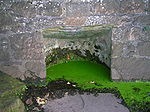
Europe
Europe is, by convention, one of the world's seven continents. Comprising the westernmost peninsula of Eurasia, Europe is generally 'divided' from Asia to its east by the watershed divides of the Ural and Caucasus Mountains, the Ural River, the Caspian and Black Seas, and the waterways connecting...
and the Middle East
Middle East
The Middle East is a region that encompasses Western Asia and Northern Africa. It is often used as a synonym for Near East, in opposition to Far East...
. Aside from the spring that issued from the staff Moses and the Well of Beersheba
Beersheba
Beersheba is the largest city in the Negev desert of southern Israel. Often referred to as the "Capital of the Negev", it is the seventh-largest city in Israel with a population of 194,300....
, there were already a number of sites mentioned in Jewish and Christian folklore, including Moses
Moses
Moses was, according to the Hebrew Bible and Qur'an, a religious leader, lawgiver and prophet, to whom the authorship of the Torah is traditionally attributed...
’ well near Mount Nebo
Mount Nebo
Mount Nebo originally referred to:* Mount Nebo , a mountain in the present day Western Jordan and the mountain where, according to the Bible, the prophet Moses diedOther uses are derived from the Biblical one, including:Australia...
, visited by the fourth-century nun Egeria and many other pilgrims. St Athanasius’ Life of St Antony
Antony
Antony is an English language variant of Anthony. It can refer to:People* Mark Antony, Roman politician and general* Antony Flew, a contemporary British philosopher* Antony Gormley, a contemporary British sculptor...
, written about 356–62, mentions the well created by the desert hermit Antony, clearly based on the precedent set by the Moses legend, and this seems to have been the original for many of the traditions associating saints with wells in Europe. It is unclear how many Christian holy wells there may have been, as records are very fragmentary and often a well appears only once, making it impossible to tell when reverence for it began and when it ceased, but by the Reformation
Protestant Reformation
The Protestant Reformation was a 16th-century split within Western Christianity initiated by Martin Luther, John Calvin and other early Protestants. The efforts of the self-described "reformers", who objected to the doctrines, rituals and ecclesiastical structure of the Roman Catholic Church, led...
England, for instance, probably possessed some hundreds. As they were closely linked with the cults of the saints, many wells in countries that converted to Protestant forms of Christianity fell into disuse and were lost, the Holy Well at Walsingham
Walsingham
Walsingham is a village in the English county of Norfolk. The village is famed for its religious shrines in honour of the Virgin Mary and as a major pilgrimage centre...
(Norfolk
Norfolk
Norfolk is a low-lying county in the East of England. It has borders with Lincolnshire to the west, Cambridgeshire to the west and southwest and Suffolk to the south. Its northern and eastern boundaries are the North Sea coast and to the north-west the county is bordered by The Wash. The county...
) being a good example, which, having been an integral element of the pilgrimage to the shrine of the Virgin Mary in the village, vanished completely. Visiting of wells for therapeutic and entertainment purposes did not completely die out, however, as spas
Spas
The article is about localities in Eastern Europe.Spas in the Slavic languages means saviour and past-tense of to save ....
became fashionable in the 17th century and later. Eventually antiquarians (from the 17th century) and folklorists (from the 19th) began to take notice of holy wells and record their surviving traditions.
Over a hundred holy wells exist in Cornwall
Cornwall
Cornwall is a unitary authority and ceremonial county of England, within the United Kingdom. It is bordered to the north and west by the Celtic Sea, to the south by the English Channel, and to the east by the county of Devon, over the River Tamar. Cornwall has a population of , and covers an area of...
, each associated with a particular saint, though not always the same one as the dedication of the church.
Several holy wells also survive in Turkey
Turkey
Turkey , known officially as the Republic of Turkey , is a Eurasian country located in Western Asia and in East Thrace in Southeastern Europe...
, called ayazma in Turkish, from Greek
Greek language
Greek is an independent branch of the Indo-European family of languages. Native to the southern Balkans, it has the longest documented history of any Indo-European language, spanning 34 centuries of written records. Its writing system has been the Greek alphabet for the majority of its history;...
(hagiasma), literally "holiness". Examples of hagiasmata are found in the Church of St. Mary of the Spring
Church of St. Mary of the Spring (Istanbul)
The Monastery of the Mother of God at the Spring or simply Zoödochos Pege , is an Eastern Orthodox sanctuary in Istanbul...
and the Church of St. Mary of Blachernae
Church of St. Mary of Blachernae (Istanbul)
Saint Mary of Blachernae is an Eastern Orthodox church in Istanbul...
, both located in istanbul
Istanbul
Istanbul , historically known as Byzantium and Constantinople , is the largest city of Turkey. Istanbul metropolitan province had 13.26 million people living in it as of December, 2010, which is 18% of Turkey's population and the 3rd largest metropolitan area in Europe after London and...
.
Historiographical controversies
The reformers of the 16th century often assumed that medieval Catholic practices embodied lingering remains of Pagan religious practices, and thought of holy wells in that way. This affected the outlook of those who came to study holy well traditions later. The pioneers of folklore study took the view that the customs and legends they were recording were debased versions of Pagan rites and myths. Thus it became standard to begin any account of holy wells with the statement that the Christian church had adopted them from the Pagans and replaced the Heathen gods with Christian saints, in order to win people over to the new religion more smoothly.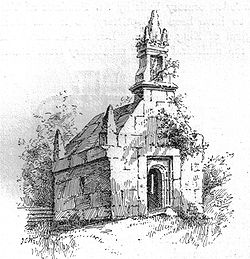
Neopaganism
Neopaganism is an umbrella term used to identify a wide variety of modern religious movements, particularly those influenced by or claiming to be derived from the various pagan beliefs of pre-modern Europe...
movement, for whom wells formed part of 'earth mysteries
Earth mysteries
The term Earth mysteries describes an interest in a wide range of spiritual, quasi-religious and pseudo-scientific ideas focusing on cultural and religious beliefs about the Earth, generally with regard to particular geographical locations of historical significance.The study of ley lines...
' study along with ley line
Ley line
Ley lines are alleged alignments of a number of places of geographical and historical interest, such as ancient monuments and megaliths, natural ridge-tops and water-fords...
s and ancient sites; the view that the Christians had ‘stolen’ holy wells from the Pagan religions fitted in well with their position. The magazines Wood and Water and Meyn Mamvro, among others, helped shape this approach. During the early- and mid-1990s this viewpoint was under increasing attack crowned by the publication of Ronald Hutton
Ronald Hutton
Ronald Hutton is an English historian who specializes in the study of Early Modern Britain, British folklore, pre-Christian religion and contemporary Paganism. A reader in the subject at the University of Bristol, Hutton has published fourteen books and has appeared on British television and radio...
’s The Pagan Religions of the Ancient British Isles (1991) which argued that the evidence for what constituted pre-Christian British religious practices, certainly outside Romano-British times, was next to nil. As far as wells themselves were concerned, the controversy emerged in the pages of Source, the holy wells journal edited by Roy Fry and former Benedictine
Benedictine
Benedictine refers to the spirituality and consecrated life in accordance with the Rule of St Benedict, written by Benedict of Nursia in the sixth century for the cenobitic communities he founded in central Italy. The most notable of these is Monte Cassino, the first monastery founded by Benedict...
monk
Monk
A monk is a person who practices religious asceticism, living either alone or with any number of monks, while always maintaining some degree of physical separation from those not sharing the same purpose...
Tristan Gray-Hulse. A number of articles in the journal challenged long-standing myths about holy well history, and the editors published an exchange between the authors and Cheryl Straffon, editor of Cornish earth mysteries magazine Meyn Mamvro, about the evidence for a particular Cornish well’s supposed association with the Irish goddess Brigid
Brigid
In Irish mythology, Brigit or Brighid was the daughter of the Dagda and one of the Tuatha Dé Danann. She was the wife of Bres of the Fomorians, with whom she had a son, Ruadán....
. The eco-pagan movement has largely accepted the new historiographical approach, but occasionally rather more old-fashioned accounts of holy wells are published, for instance Gary Varner’s Sacred Springs (2002).
A linked argument was over the nature of the influence of the Celt
Celt
The Celts were a diverse group of tribal societies in Iron Age and Roman-era Europe who spoke Celtic languages.The earliest archaeological culture commonly accepted as Celtic, or rather Proto-Celtic, was the central European Hallstatt culture , named for the rich grave finds in Hallstatt, Austria....
s on the well cult. The late Francine Nicholson, an independent student of Celtica, argued forcefully and controversially that the Celts had a unique sensitivity to sacred wells, but never elaborated this in any published work.
More recently, radically minded scholars have begun questioning the unity of concepts imposed by the term ‘holy well’. In a paper in the Living Spring Journal, Jeremy Harte distinguishes between early Anglo-Saxon ‘holy wells’ and those Christianised in the late Middle Ages, and argues ‘apart from being venerated and being wet, they have little in common’; Harte has also stressed that limited evidence may mean that scholars are considerably overestimating the number of holy wells which were active at any one time.
Revival of modern interest
In a sense, the restoration of holy wells began almost as soon as they were in decline, as a number became the subject of antiquarian interest and some were turned into garden features and put to other decorative uses. However, in more modern times wells have been restored as an expression of interest in the past, sometimes from romanticRomanticism
Romanticism was an artistic, literary and intellectual movement that originated in the second half of the 18th century in Europe, and gained strength in reaction to the Industrial Revolution...
or religious motives, but mostly as a statement of continuity with the history of a particular community. A good example is St Osyth’s Well at West Bierton (Buckinghamshire
Buckinghamshire
Buckinghamshire is a ceremonial and non-metropolitan home county in South East England. The county town is Aylesbury, the largest town in the ceremonial county is Milton Keynes and largest town in the non-metropolitan county is High Wycombe....
), ‘restored’ (and in the process rebuilt completely) by the Parish Council as part of a project marking Millennium
Millennium
A millennium is a period of time equal to one thousand years —from the Latin phrase , thousand, and , year—often but not necessarily related numerically to a particular dating system....
Year in 2000.
The most active holy wells in Britain are those linked to Christian pilgrimages, at Walsingham, Fernyhalgh (Lancashire
Lancashire
Lancashire is a non-metropolitan county of historic origin in the North West of England. It takes its name from the city of Lancaster, and is sometimes known as the County of Lancaster. Although Lancaster is still considered to be the county town, Lancashire County Council is based in Preston...
) and Holywell
Holywell
Holywell is the fifth largest town in Flintshire, North Wales, lying to the west of the estuary of the River Dee.-History:The market town of Holywell takes its name from the St Winefride's Well, a holy well surrounded by a chapel...
(Wales
Wales
Wales is a country that is part of the United Kingdom and the island of Great Britain, bordered by England to its east and the Atlantic Ocean and Irish Sea to its west. It has a population of three million, and a total area of 20,779 km²...
), or popular tourist sites (Bath, Somerset). The Chalice Well
Chalice Well
Chalice Well is a holy well situated at the foot of Glastonbury Tor in the county of Somerset, England. The natural spring and surrounding gardens are owned and managed by the Chalice Well Trust , founded by Wellesley Tudor Pole in 1959.Archaeological evidence suggests that the well has been in...
at Glastonbury
Glastonbury
Glastonbury is a small town in Somerset, England, situated at a dry point on the low lying Somerset Levels, south of Bristol. The town, which is in the Mendip district, had a population of 8,784 in the 2001 census...
(Somerset) is at the centre of a Neopagan
Neopaganism
Neopaganism is an umbrella term used to identify a wide variety of modern religious movements, particularly those influenced by or claiming to be derived from the various pagan beliefs of pre-modern Europe...
- and New Age
New Age
The New Age movement is a Western spiritual movement that developed in the second half of the 20th century. Its central precepts have been described as "drawing on both Eastern and Western spiritual and metaphysical traditions and then infusing them with influences from self-help and motivational...
-orientated spirituality and retreat centre. Other wells, however, are often visited on an informal basis for religious or sightseeing reasons. New forms of holy well reverence continue to emerge now and again, notoriously the so-called Well of the Triple Goddess
Triple deities
A triple deity is a deity associated with the number three. Such deities are common throughout world mythology; the number three has a long history of mythical associations. C. G...
at Minster-in-Sheppey
Minster-in-Sheppey
Minster is a small town on the north coast of the Isle of Sheppey and in the Swale district of Kent, England.-Toponymy:The name of the town derives from the monastery founded in the area...
(Kent
Kent
Kent is a county in southeast England, and is one of the home counties. It borders East Sussex, Surrey and Greater London and has a defined boundary with Essex in the middle of the Thames Estuary. The ceremonial county boundaries of Kent include the shire county of Kent and the unitary borough of...
). In 2001 Channel 4’s Time Team
Time Team
Time Team is a British television series which has been aired on Channel 4 since 1994. Created by television producer Tim Taylor and presented by actor Tony Robinson, each episode features a team of specialists carrying out an archaeological dig over a period of three days, with Robinson explaining...
were responsible for exposing the infamous archaeological fraud of Llygadwy
Llygadwy
Llygadwy is a site in SE Wales where one people appear to have been "salting" the environs of a natural spring with archaeological relics for reasons that can only be a matter of speculation...
, a site which included an alleged holy well.
Historiographically, the publication of Janet and Colin Bord’s Sacred Waters (1985) was influential in reviving interest in the history and folklore of holy wells in Britain. The same year saw the foundation of the journal Source by Mark Valentine. Attempts to maintain a regular journal for the study of holy wells have been erratic (Source enjoyed two runs from 1985–89 and 1994–98, and the web-based Living Spring has only had two issues to date) but postings on websites such as The Megalithic Portal show that there is still much interest in this category of ancient site.
Case study: the necessity of vigilance in preservation of heritage
Often unmarked on maps and undistinguished by archaeological features, holy wells are a uniquely vulnerable category of ancient site. They continue to be lost to farming, drainage work, development or neglect. A recent instance is the desecrationDesecration
Desecration is the act of depriving something of its sacred character, or the disrespectful or contemptuous treatment of that which is held to be sacred or holy by a group or individual.-Detail:...
of St Bridget’s Well at Rosepark, Balrothery (County Dublin, Ireland
Ireland
Ireland is an island to the northwest of continental Europe. It is the third-largest island in Europe and the twentieth-largest island on Earth...
), destroyed by building work in 2003 despite being a protected monument. and the destruction of a well at Rath Lugh during the construction of the M3 Motorway in the Tara-Skryne Valley, Ireland.
See also
- Clootie wellClootie wellClootie wells are places of pilgrimage in Celtic areas. They are wells or springs, almost always with a tree growing beside them, where strips of cloth or rags have been left, usually tied to the branches of the tree as part of a healing ritual...
- Nature worshipNature worshipNature worship describes a variety of religious, spiritual and devotional practices that focus on natural phenomenon. A nature deity can be in charge of nature, the biosphere, the cosmos or the universe. Nature worship can be found in panentheism, pantheism, deism, polytheism, animism, totemism,...
- Water deityWater deityA water deity is a deity in mythology associated with water or various bodies of water. Water deities are common in mythology and were usually more important among civilizations in which the sea or ocean, or a great river was more important...
- Well dressingWell dressingWell dressing is a summer custom practised in rural England in which wells, springs or other water sources are decorated with designs created from flower petals...
- Well of Wyrd

